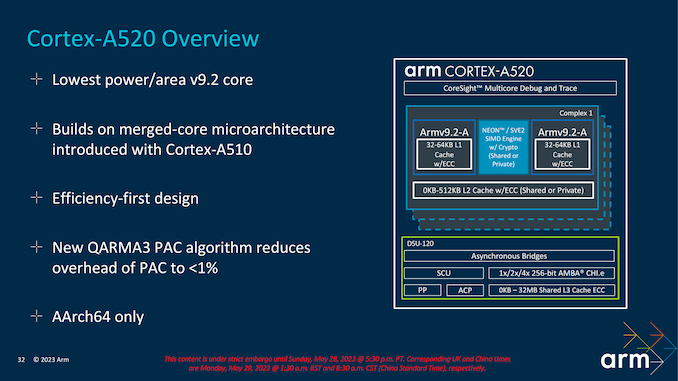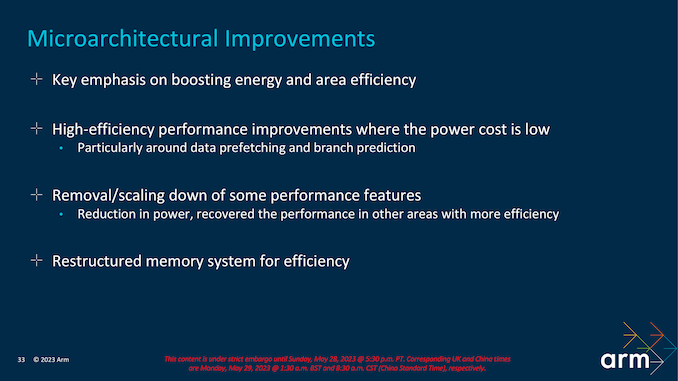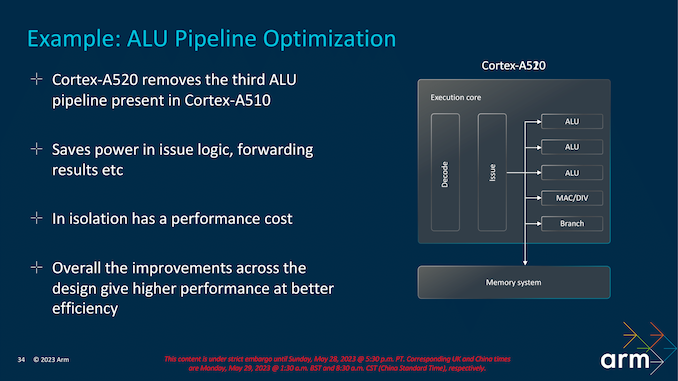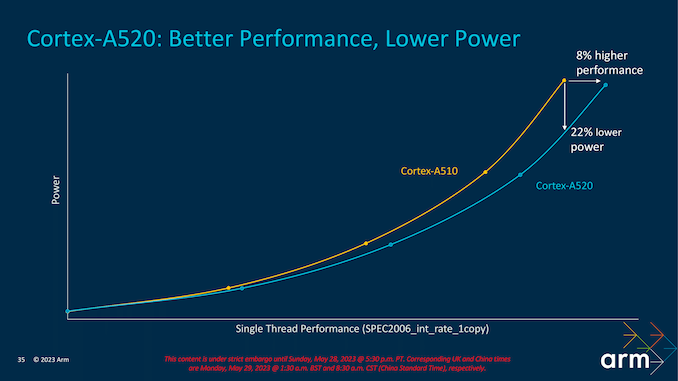Arm Unveils 2023 Mobile CPU Core Designs: Cortex-X4, A720, and A520 - the Armv9.2 Family
by Gavin Bonshor on May 28, 2023 8:30 PM ESTCortex-A520: LITTLE Core with Big Improvements
The third of the Armv9.2 cores is the Cortex-A520, which is little in design, but Arm promises big improvements over previous generations, particularly on power efficiency.
Addressing the biggest question right off the bat: no, Cortex-A520 is not an out-of-order core design. True to Arm's little core design ethos, it's still an in-order core – and in fact, Arm has even removed an ALU in the process.
Arm's smallest core for this generation is a new core in effect, but it is still more of a refinement of the Cortex-A510 than a completely new design. It has the lowest power-to-area ratio of all three announced Cortex Armv9.2 cores. The most significant differences come through optimizations on power, with Arm claiming that the Cortex-A520 is 22% more energy efficient than the previous Cortex-A510 core at iso-process and iso-frequency. The little core in Arm's TCS23 catalog is primarily designed for performing low-intensity and background operational tasks, which takes these loads off bigger cores such as the Cortex-A720/Cortex-X4 to allow better power efficiency overall within the cluster.
Many of Arm's efficiency gains come from small, microarchitectural level changes, mostly around how it implements data prefetch and branch prediction. On the whole, not much has been changed to the little core, but the small changes that have been made have all been about improving efficiency.
One of the non-architectural areas of improvement has been introducing the new QARMA3 Pointer Authentication Code (PAC) algorithm, which Arm claims to reduce PAC's overhead to under 1%. QARMA3 is a cryptographic-based technique designed to ensure the pointers' integrity is correct and accurate. It also provides a secure and efficient way to avoid tampering with the necessary underlying code so that any authorized modifications or tampering if the pointers are eliminated adds a layer of hardware-level security. Arm is not only leveraging QARMA3 PAC to boost security and integrity, but it also allows them to squeeze out additional levels of efficiency, if compared to using PAC with older algorithms.
Much like when Arm announced its armv9 architecture in 2021, the small Cortex-A520 cores can be merged in pairs to share pipelines and improve efficiency. Adopting a pairing of the smaller Cortex-A520 cores can enhance efficiency by combining them through relevant pipelines such as SVE, NEON, and FP. More so in the case of SVE2, which does require a larger area footprint than other executions and makes sense to pair two smaller cores than have just one on its own. However, it is entirely plausible and possible for SoC vendors to use single-core option implementations on their designs if they wish to do so.
Sometimes less is more, and in the case of the Cortex-A520, Arm has removed the third ALU pipeline, which it originally added to the Cortex-A5x DNA with the Cortex-A510. Arm's ideology behind this is it saves power in issue logic and improves forwarding results within the overall complexity of the pipeline. In practice, Arm has figured out how to recover enough of the lost performance through other improvements that they are opting to eat the hit from removing the ALU in order to minimize core size and maximize efficiency.
Ultimately, Arm is looking at a big-picture trade-off as well; reducing the power consumption of the Cortex-A520 frees up energy that can be allocated to the other cores, such as the Cortex-A720 and even the Cortex-X4 where applicable. This makes Armv9.2 IP versatile and scalable, making small savings where it can deliver the savings in other areas where and when it is needed.
Using SPEC2006_int_rate_1copy as its performance metric to judge performance and efficiency, generation on generation (and at iso-process and iso-frequency), Arm is claiming the Cortex-A520 delivers 8% more performance than the Cortex-A510 at similar levels of power consumption. Alternatively, at iso-performance, Cortex-A520 can deliver a significant 22% power savings.
While seemingly small, it can add up in the grand scheme of things, especially across a four-core complex of Cortex-A520 cores. Although there's always a diminishing level of returns in terms of increasing core count when it comes to performance, having lower-powered and more efficient cores typically creates more power for other areas to tap into, such as the big Cortex-X4 core, which requires more grunt to boost those intensive and burst reliant workloads.














52 Comments
View All Comments
Ryan Smith - Monday, May 29, 2023 - link
Thanks!GC2:CS - Tuesday, May 30, 2023 - link
Mediatek dimensity 93004xx4 + 4x A720 no little cores. 50% lower power, beats next gen Apple CPU (A17).
First time one ever with more than 3 X CPU’s ?
https://m.gsmarena.com/mediatek_dimensity_9300_tip...
iphonebestgamephone - Tuesday, May 30, 2023 - link
8cx gen 3 - 4x x1 + 4x a78tipoo - Thursday, June 1, 2023 - link
Given that A17 isn't out yet, how do we know?Zoolook - Sunday, June 4, 2023 - link
4 X4s would make for a very big chip, I doubt it, but we'll see, A17 is on N3 and Dimensity 9300 will be on N4P so also doubt that.NextGen_Gamer - Tuesday, May 30, 2023 - link
Is there going to be another follow-up article about the new Immortalis-G720 GPU?brucethemoose - Tuesday, May 30, 2023 - link
^I think the GPU is becoming the more critical part in phones... I hate to downplay CPU advances, but what does being faster than an X1 really get you on mobile these days?
GPUs, on the other hand, are the bottleneck for running local AI. Flagships can already run 7B LLMs and other generative models reasonably well, but every ounce of extra GPU speed allows for significantly better inference. They are also the bottleneck for VR/AR and ports of PC/console games.
nandnandnand - Tuesday, May 30, 2023 - link
The real advance for CPU might be locking the performance in place but lowering the power usage. Which is why we're hearing about Dimensity 9300 supposedly packing four Cortex-X4 cores and four Cortex-A720 cores, with no presence of Cortex-A520. In a smartphone SoC.Shouldn't these flagships being using their dedicated AI accelerators instead of the GPU for inference?
TheinsanegamerN - Wednesday, May 31, 2023 - link
AI accelerators are just that, accelerators. You still need heavy compute power, and that comes from GPUs.nandnandnand - Wednesday, May 31, 2023 - link
I don't think an iGPU is significantly more powerful than an AI accelerator.